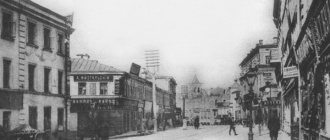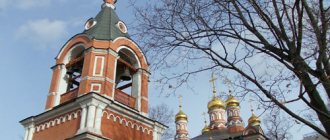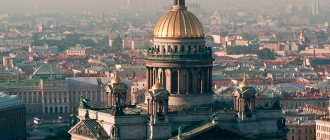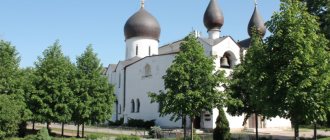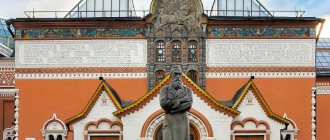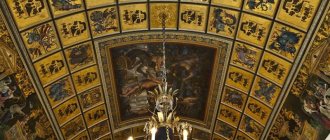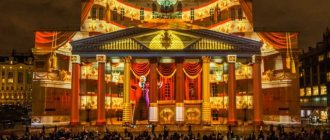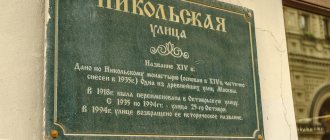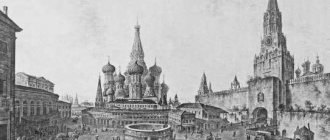Portrait of wife and children's books
From 1906 to 1928, the Sytin family lived nearby - in a five-story mansion they owned on Strastnaya (now Pushkinskaya) Square.
The chic Art Nouveau building, which was created by architect Adolf Erichson, engineer Konstantin Shukhov and artist Ivan Bilibin, also housed the editorial office of Sytin’s newspaper “Russian Word”, a bookstore and a printing house. You can still see this building today - it is located at Tverskaya Street, building 18. In 1928, the mansion was occupied by the editorial office of the newspaper Pravda, and Sytin was given an apartment in the house across the boulevard. The exchange turned out to be unequal - five rooms for five floors.
After the revolution, Sytin met with Lenin and worked for the Soviet government - he had the right to free entry and exit from Moscow, and arranged the supply of paper from Germany and Finland. In 1924, he was sent to America in the unusual role of impresario. He was supposed to organize an exhibition of Soviet artists, but the trip was unsuccessful. Nevertheless, in 1928, Sytin received an apartment, and was also one of the first in the country to receive a personal pension. First 150 rubles, then 250.
“This apartment is large - 115 square meters, five rooms. But he wasn't hanging out here alone. 15 people moved in with him - his children, grandchildren, sons Vasily and Nikolai and their families,” says Olga Vinogradova, head of the memorial and fund sector of the museum-apartment’s fund department. – His wife, Evdokia Ivanovna Sytina, never visited this apartment - she died in 1924 and was buried in the necropolis of the Strastnoy Monastery. Her grave, like the monastery, has not survived. However, in the corridor we are greeted by an authentic ceremonial photograph of Ivan Dmitrievich and his wife, created in 1901. Suitcases made in Germany that belonged to Sytin are also located here. He often went there to buy paper. His name is written inside the hat box.”
The first room, the largest in the apartment, was divided into three parts by partitions under the Sytins. The youngest children lived here - Dmitry, Olga and Anna. Now you can see a working model of a printing press and children's books from the Sytin printing house.
Sytin not only made money from book publishing. He sought to spread knowledge among the people. All children's publications were educational, with realistic illustrations. It is known that the publisher sent artists from the workshop at the printing house to zoos, even foreign ones, so that they could study animals.
Photo: mos.ru
Photo: mos.ru
Photo: mos.ru
Photo: mos.ru
Architecture
The five-story stepped building was erected in the early modern style[2]. From an architectural point of view, the curved lines of the end and facade, decorated according to the sketches of the artist and illustrator I. Ya. Bilibin, the massive mezzanine and the unusual design at the end are of interest. Noteworthy are the hanging corner cornices, the stability of which is ensured by special support, balconies of various shapes and sizes, and complex weaving of windows[2]. The natural motif characteristic of Art Nouveau can be seen in the shapes of cast-iron gratings and in mosaic patterns with a golden tint and variegated scarlet poppies[2].
Three classes of education and innate entrepreneurial acumen
The next room is dedicated to the biography of Sytin. The most influential publisher of pre-revolutionary Russia was born in 1851 in the village of Gnezdikovo, Soligalichsky district, Kostroma province. His father managed to make his way from state peasant to volost clerk, but he was burdened by his position, drank, and left home. When Sytin Sr. lost his job, it became clear that the first of his four children would not stay in school.
After completing three grades, 12-year-old Vanya went into the service of his uncle, who traded furs at the Nizhny Novgorod fair. Later he found himself in Moscow running errands for the merchant Pyotr Nikolaevich Sharapov. There he first encountered book products. The merchant kept two shops - a fur shop and a bookstore. There was no room in the fur shop, and Sytin had to work in the second one.
The original documents stored in the museum remind us of this period in the life of the future entrepreneur: an agreement with Sharapov and letters from his parents, touchingly addressed “to Moscow, near the Ilyinsky Gate, to the bookstore of the merchant P.N. Sharapova to Ivan Dmitrievich Sytin."
“Sharapov fell in love with him, took part in his fate, even to the point of choosing a bride for him - Evdokia Ivanovna from the Sokolov family (there were such Moscow confectioners). Sytin took a dowry of four thousand rubles for her. Having borrowed another three thousand from Sharapov, he bought a lithographic machine for the production of popular prints and opened his own business on Voronukhina Gora, in the area of the modern Dorogomilovsky Bridge. It was December 7, 1876,” says Olga Vinogradova.
Sytin earned his first capital by showing his entrepreneurial flair during the next Russian-Turkish war. This is how he himself described it in his memoirs:
“On the day war was declared, in April 1877, I ran to Kuznetsky Most, bought a map of Bessarabia and Romania and told the master to copy part of the map during the night indicating the place where our troops crossed the Prut. At five o'clock in the morning the card was ready and put into the machine with the inscription: “For newspaper readers. Allowance.” As the troops moved, the map changed. For three months I traded alone. Nobody even thought of interfering with me.
There were few competitors at all. Other traders did not take risks. No expenses were made to improve production. In my new business, I acted in a new way: I invited capable draftsmen and dedicated printers, paid them more, but demanded better work, studied the tastes of the people. The results were brilliant. My folk paintings were the most popular. The merchants bargained with me on quantity, not price. There weren’t enough goods for everyone.”
Photo: mos.ru
Photo: mos.ru
Photo: mos.ru
Photo: mos.ru
Fourth Estate
Of many writers, Sytin was especially close to Anton Chekhov. The playwright predicted great success for him in the newspaper business. The idea of publishing a popular, publicly accessible newspaper soon became a reality. In 1897, the Partnership I.D. Sytin" bought "Russian Word", whose circulation he managed to increase hundreds of times. The best journalists of that time wrote for the newspaper: Vladimir Gilyarovsky, Vlas Doroshevich, Fyodor Blagov. The record circulation of the publication after February 1917 reached 1.2 million copies. Today we would call Sytin a media tycoon - in addition to the Russian Word, his partnership owned 9 newspapers and 20 magazines, one of which is still published under its original name - Around the World.
"Don Quixote of La Mancha." Edition for children. Printing house of the Ivan Sytin Partnership. Photo: e-reading.club
The building of the printing house of the Ivan Sytin Partnership in Moscow. Photo: zamos.info
"Universal Russian calendar". Printing house of the Ivan Sytin Partnership. Photo: e-reading.club
Popular demand: from popular print to Leo Tolstoy
Around the same time, Sytin began publishing popular prints in color - with the lives of saints and secular content. Color printing made production somewhat more expensive, but due to large print runs and demand, we managed to keep the price affordable. By the end of the 19th century, Sytin became the largest manufacturer of popular prints in Moscow - his printing house produced more than two million popular prints per year.
“What we call pulp fiction sold well: astrology, adventure and romance novels. All this was carried around the villages by ofeni book-carriers. Coming from a village, Sytin knew how it worked, so he created a whole network of distributors. How he indulged popular demand can be seen from the covers of “Boris Godunov” or “Woe from Wit,” veiled as romance novels,” says Olga Vinogradova.
The Partnership of I. D. Sytin and Co. treated the common man with deep respect. “Perhaps this is the only publishing company in Russia where the Russian spirit smells and the man-buyer is not pushed in the neck,” Anton Chekhov wrote about him in a letter to Alexei Suvorin.
Photo: mos.ru
In 1884, Sytin began producing affordable calendars, which before him had been a luxury item. From his printing house came the general Russian calendar, the general useful calendar, the Old Believer calendar, the military calendar, the historical calendar - it’s impossible to list all the types. Tear-off calendars with useful information for every day, which Sytin came up with the idea of printing in 1886, created a real sensation.
He not only created trends, but also knew how to catch them. When the fashion for vegetarianism reached Russia in 1913, Sytin immediately began printing vegetarian menus on calendars along with fasting and fasting recipes.
A special line in Sytin’s biography is his collaboration with Leo Tolstoy and the Posrednik publishing house. The Sytinsky printing house has published a series of books accessible to the people by famous writers: Tolstoy himself, Vsevolod Garshin, Vladimir Korolenko, Maxim Gorky and others. The series also includes an album of reproductions of Russian Itinerant artists - Ilya Repin, Vasily Perov, Vasily Pukirev, Grigory Myasoedov, Konstantin Savitsky.
“The series did not bring much profit, but Sytin’s authority as a publisher increased noticeably,” notes Olga Vinogradova, “after all, now he was publishing serious books for the people, not pulp fiction. He also began publishing textbooks. Perhaps the pinnacle of his publishing activity were such luxurious publications as the historical multi-volume “Three Centuries”, dedicated to the 300th anniversary of the Romanov dynasty, as well as the Children’s and People’s Encyclopedias.”
Photo: mos.ru
Awaken the mind
Until 1865, the right to publish calendars belonged exclusively to the Academy of Sciences. For the majority of illiterate people, they were the most accessible printed publication. Sytin compared the calendar to “the only window through which they looked at the world.” He took the release of the first “National Calendar” with particular seriousness - preparation took five years. Sytin wanted to make not just a calendar, but a reference book and a universal reference book for all occasions for many Russian families. In order to publish the calendar “very cheaply, very elegantly, very accessible in content” and, of course, in large quantities, Sytin purchased special rotary machines for the printing house, the mechanism of which significantly increased the rate of production.
Sytin's business quickly became profitable. Understanding what topics arouse the greatest interest among the people, he created popular and in-demand products. So his first big income came from battle sketches and maps with explanations of military actions, which he published during the Russian-Turkish War.
In 1879, Sytin bought a house on Pyatnitskaya Street, where he already installed two lithographic machines, and three years later he registered the I.D. Partnership. Sytin and Co., whose fixed capital was 75 thousand rubles. At the All-Russian Art Exhibition, Sytin’s products were awarded a bronze medal, and by the end of the 1890s, his printing houses produced almost three million pictures and about two million calendars annually.
Ivan Sytin's store in Nizhny Novgorod. Photo: livelib.ru
Ivan Sytin in his office. Photo: rusplt.ru
The building of the Sytinskaya printing house on Pyatnitskaya street, Moscow. Photo: vc.ru
Five portraits, lamp and bust
The next room contains furniture and decorative arts that belonged to Ivan Dmitrievich and his family. On the walls are five portraits that Sytin transported from the mansion: his parents, his wife, his eldest son Vasily and Nikolai Tulupov, a famous teacher and colleague of the publisher.
The portrait of the publisher's wife was painted by Alexander Moravov. He also created the most famous image of Sytin, which is now in the Taganrog Art Museum. Moravov taught for several years at the art and printing school at the Sytin publishing house and worked on the album “Russian History in Pictures.” The portrait of Vasily Sytin was painted by Georgy Alekseev, known for preparing for the publication of one of the most original textbooks on mathematics for children - “Elementary elementary geometry in pictures for coloring”, also published by the Sytin Partnership.
“Some pieces of furniture were ordered by Ivan Dmitrievich from the famous Abramtsevo workshops. Of course, they were not bought for this apartment, but moved from the mansion, like this beautiful clock with lions and the “Autumn” candelabra from the French company of the Moreau brothers,” explains Olga Vinogradova. – Nearby, in the corridor, is a bust of Sytin by the famous sculptor Ilya Ginzburg. Once upon a time, the bust stood in the editorial office of “Russian Word.”
Photo: mos.ru
Photo: mos.ru
Photo: mos.ru
Photo: mos.ru
Voltaire's chair and wedding ticket
Sytin lived in this apartment for his last seven years. The smallest room, which Ivan Dmitrievich occupied, is dedicated to them - he settled the children in the larger ones. The Holy of Holies is what the museum staff call the room today.
“Here stood his bed, his favorite Voltaire chair, his cane,” says Olga Vinogradova. – Nearby there is a table with writing instruments and another work by Gunzburg – a figurine of Leo Tolstoy. On the shelf are two iconic publications for Sytin - the complete works of Lev Nikolaevich and the Military Encyclopedia, which caused a lot of noise. Sytin attracted the best specialists in the field of military affairs to work on it, but due to the outbreak of the First World War, only 18 of the 23 planned volumes were released.”
One of the most touching exhibits in this room is a wedding card from 1876 with an invitation to the celebration and ball on the occasion of the wedding of Ivan Dmitrievich and Evdokia Ivanovna. They lived together for almost 50 years, raising 10 children - six boys and four girls.
Photo: mos.ru
Photo: mos.ru
Photo: mos.ru
Photo: mos.ru
Sytin Ivan Dmitrievich. Living for books
I.D. Sytin. Portrait by A.V. Moravova, 1908
“I believe in the future of Russian enlightenment, in the Russian person, in the power of light and knowledge.” Iv. Sytin.
Among the most famous names of Russian entrepreneurs who glorified Russia is the name of I.D. Sytin occupies one of the most honorable places. He came from poor Kostroma peasants, a first-generation merchant, and became one of the leading educators in Russia at the beginning of the 20th century, the creator and head of the country's largest publishing and printing enterprise.
At the beginning of the twentieth century, the name of Ivan Sytin was known throughout Russia. During his life, he published a total circulation of 500 million books: every home had a Sytin primer, thanks to his publishing house, millions of children learned about foreign writers, he was the first to print complete works of Russian classics. He was called “American” for his love of technical innovations.
Ivan Dmitrievich Sytin lived a long, eventful life and remained in the memory of several generations of compatriots as a man who fought for the enlightenment of the common people. He said: “During my life, I believed and believe in one force that helps me overcome all the hardships of life. I believe in the future of Russian enlightenment, in the Russian person, in the power of light and knowledge”[1]. Having set his life goal to educate the people, Sytin ensured that by the beginning of the 20th century his enterprises produced a quarter of all printed publications in the country.
I.D. Sytin. 1873
The future book publisher was born under serfdom on January 25, 1851 in the small village of Gnezdnikovo, Soligalichsky district, Kostroma province. He was the eldest of four children of the volost clerk Dmitry Gerasimovich Sytin and his wife Olga Alexandrovna. Since the family lived very poorly, at the age of 12 Ivan left school and went to work in Nizhny Novgorod, where his uncle traded furs. Things weren't going well for the relative, so the boy, who even helped carry skins and swept the shop, was an extra mouth in the family. In this regard, two years later his uncle sent him to Moscow, to his friend, the Old Believer merchant Pyotr Sharapov, who held two trades at the Ilyinsky Gate - furs and books. By a lucky coincidence, the new owner did not have a place in the fur shop where the relatives sent the boy, and in September 1866 Sytin began to serve “in the book business.”
The career of the future publisher began in 1866 in the bookstore of the merchant Sharapov at the Ilyinsky Gate, where Ivan Sytin entered the service as a teenager.
In 1876, Ivan Sytin married Evdokia Ivanovna Sokolova, the daughter of a Moscow merchant-confectioner, and received 4 thousand rubles as a dowry for his wife. This allowed him, by borrowing another 3 thousand from Sharapov, to buy his first lithographic machine. At the end of the same year, he opened a printing workshop on Voronukhina Gora near the Dorogomilovsky Bridge, which gave birth to a huge publishing business. It is this event that is considered the moment of birth of the largest printing enterprise MPO “First Exemplary Printing House”. The Sytins had 10 children, of whom the four eldest sons, having matured, began to work with their father.
Sytin's lithography was very modest, it occupied only three rooms, and its printed editions at first were almost no different from the mass production of the Nikolsky market. But Ivan Dmitrievich was very inventive: so with the beginning of the Russian-Turkish War of 1877-1878, he began to produce maps indicating military operations and the inscription: “For newspaper readers. Manual and battle paintings." These were the first such mass publications in Russia. They had no competitors, the product sold out instantly and brought fame and profit to the publisher[2].
In 1878, the lithography became the property of Sytin, and the following year he had the opportunity to buy his own house on Pyatnitskaya Street, equip a printing house in a new location and purchase additional printing equipment. Five years later, a book publishing company was established, the trading shop of which was located on Old Square. At first, the books were not of high taste. Their authors did not disdain plagiarism. Sytin said at that time: “With instinct and guesswork, I understood how far we were from real literature, but the traditions of the popular book trade were very tenacious, and they had to be broken with patience.”[3]
Very soon, Ivan Dmitrievich was able to organize not only the preparation and production of printed materials at his own printing facilities, but also the successful sale of popular prints. He created a unique sales network of traveling salesmen, covering the entire country. Then, publications of a different type began to spread according to the same pattern. Sytin's merit was that he correctly determined which publications belonged to the future, and gradually began to replace popular prints with new literature through his sales system. Many educational publishing houses (“Moscow Literacy Committee”, “Russian Wealth”, etc.) entrusted Sytin with the production and sale of their publications for the people[4].
In the fall of 1884, Chertkov, who represented the interests of L.N., came into the shop on Old Square. Tolstoy, and proposed for publication the stories of N. Leskov, I. Turgenev and Tolstoy’s “How People Live.” These more informative books were supposed to replace the primitive editions that were being published and be extremely cheap, at the same price as the previous ones - 80 kopecks per hundred. Sytin accepted the offer. This is how the new cultural and educational publishing house “Posrednik” began its activities, which in the first four years alone published 12 million copies of books with the works of famous Russian writers.
Ivan Dmitrievich looked for opportunities to publish other publications that would help educate the people. In the same 1884, Sytin’s first “General Calendar for 1885” appeared at the Nizhny Novgorod Fair: “I looked at the calendar as a universal reference book, as an encyclopedia for all occasions”[5]. Business went well, and soon a second bookstore was opened in Moscow on Nikolskaya Street.
I.D. Sytin and L.N. Tolstoy
The following year, Sytin bought Orlov’s printing house with five printing presses and selected qualified editors. He entrusted the design of the calendars to first-class artists, and consulted with L.N. about the content. Tolstoy. As a result, the “Universal Calendar” reached a huge circulation of 6 million copies, and detachable “diaries” were also issued. The extraordinary popularity of new products required a gradual increase in the number of calendar titles. Their number reached 21, each produced in millions of copies[6].
In 1887, 50 years had passed since Pushkin’s death, and independent publishers were able to print his works free of charge. Sytin's enterprise immediately responded to this event by releasing an excellent ten-volume collected works of A.S. Pushkin. In the process of work, Ivan Dmitrievich became close to progressive figures of Russian culture and learned a lot from them, making up for the lack of education. Together with figures of public education D. Tikhomirov, V. Bekhterev, N. Tulupov and others. Sytin published brochures and paintings recommended by the Literacy Committee, and published a series of folk books under the motto “Truth.”
One of the workshops of I.D. Sytin’s Printing House
Having become a member of the Russian Bibliographic Society at Moscow University in 1890, Ivan Dmitrievich took upon himself the labor and expenses of publishing the journal “Book Science”. By that time, his company was producing mass editions of cheap editions of the classics, numerous visual aids, literature for educational institutions and extracurricular reading, popular science series designed for a variety of tastes and interests, colorful books and fairy tales for children, and children's magazines.
In 1889, the book publishing “Sytin Partnership” was established with a capital of 110 thousand rubles. Ivan Dmitrievich became the owner of the country's largest publishing and printing complex. He controlled prices on the market, having his own share of at least 20% in the production of people's books. The monopoly position in the market made it possible to create the necessary reserves for technical re-equipment and modernization of production, and thanks to control over the sales network, Sytin was able to calmly and systematically concentrate the printing capacities in his hands[7].
Rotary printing presses, which had appeared in Europe by this time, were an order of magnitude more expensive than flat-plate printing presses, but at the same time sharply reduced production costs provided there was sufficient loading and large print runs. The price reduction, in turn, meant a transition to the mass market. In the conditions of the crisis of 1891–1892, which led to a drop in demand for book products, tear-off calendars remained the most popular popular publication, for the production of which Sytin purchased the first two-color rotary machine in Russia.
Folk calendars - publicly accessible home encyclopedias, from which Russian people could learn everything they needed - brought their publisher both all-Russian fame and super-profits. Further work in this direction meant not only monopolization, but the merging of private capital with the state. Over time, Sytin began to simply buy publishing and printing projects that were interesting to him. In 1893 he met A.P. Chekhov, who insisted that Sytin begin publishing a newspaper. Ivan Dmitrievich acquired the popular magazines “Niva” and “Around the World”, the newspaper “Russian Word”, which was the first to open its own news offices in various cities of the country, collaborated with talented journalists and at the beginning of the 20th century had a circulation of about a million copies. Sytin's corporation absorbed the printing houses of Vasiliev, Solovyov, Orlov, and brought the largest publishing houses of Suvorin and Marx under its control.
Much attention was paid to advertising in the Partnership. Wholesale and retail catalogs were published annually, which made it possible to widely advertise their publications and ensure the timely sale of literature through wholesale warehouses and bookstores. Over ten years, from 1893 to 1903, the turnover of Sytin’s company increased 4 times, despite the consequences of the crisis of 1900–1902. The inclusion of bankers on the board of the Partnership and the widespread use of bank loans at preferential interest rates allowed the monopolist to continue its offensive in the market. The company's dividends were the highest in the industry, and its shares (unlike those of other publishers) were listed on the stock exchange.
New projects required expansion of the business, and by 1905 three buildings of the next printing house had already been erected on Pyatnitskaya and Valovaya streets. By this time, under the leadership of the architect Erichson, a four-story house on Tverskaya was built and acquired a modern look. At the same time, the so-called “Sytinskaya Tower” appeared - a five-story production building, which now houses the small newspaper rotation of the Izvestia publishing house. The buildings had strong reinforced concrete floors, which to this day can withstand any printing equipment.
Sytin, a native of the people, always wanted to help his workers learn and teach their children, so he created a school of technical drawing and technical business at the printing house, the first graduation of which took place in 1908. When recruiting, they took the children of the Partnership’s employees, as well as those residents of villages and hamlets who had primary education. General education was supplemented in evening classes. Training and full maintenance of students was carried out at the expense of the company.
Educated Sytin workers became active participants in the revolutionary movement. They stood in the first ranks of the rebels in 1905 and published the first issue of Izvestia of the Moscow Council of Workers' Deputies, which declared a general political strike. The printing house simultaneously printed classics and contemporaries, monarchists and Bolsheviks, liberals and conservatives. On neighboring presses they printed eulogies to Nicholas II and the “Manifesto of the Communist Party”, of which about 3 million copies were produced in just two years of the revolution of 1905-1907.
One night, retaliation ensued: one of the printing houses was set on fire. The walls and ceilings of the recently built main building of the factory collapsed, printing equipment, finished editions of publications, paper supplies, and art blanks for printing were lost under the rubble. This was a huge loss for an established business. Ivan Dmitrievich received sympathetic telegrams, but did not give in to despondency. Within six months, the building was rebuilt, art school students restored drawings and cliches, and produced originals of new covers, illustrations, and screensavers. New machines were purchased and work continued. By 1911, the company's turnover exceeded 11 million rubles. At the same time, Vasily Petrovich Frolov was appointed to the post of general director, who began his career in Sytin lithography as a typesetter.
Sytin constantly conceived and implemented new publications: for the first time in Russia, the publication of multi-volume encyclopedias was undertaken - People's, Children's and Military. In 1911, a magnificent publication “The Great Reform” was published, dedicated to the 50th anniversary of the abolition of serfdom, and the following year - a multi-volume anniversary publication “The Patriotic War of 1812 and Russian Society. 1812 - 1912", in 1913 - a historical study about the tercentenary of the House of Romanov - “Three Centuries”.
The network of bookselling enterprises of the Partnership has also expanded. By 1917, Ivan Dmitrievich had 4 stores in Moscow and 2 in Petrograd, as well as bookstores in Kleve, Odessa, Kharkov, Yekaterinburg, Voronezh, Rostov-on-Don, Irkutsk, Saratov, Samara, Nizhny Novgorod, Warsaw and Sofia (together with Suvorin). Each store, in addition to retail trade, was engaged in wholesale operations. Sytin came up with the idea of delivering books and magazines to factories. Orders for delivery of publications from catalogs were completed within 2-10 days, since the system for sending literature by cash on delivery was well established.
In 1879, Sytin bought a house on Pyatnitskaya Street, where he already installed two lithographic machines, and three years later he registered the I.D. Partnership. Sytin and Co., whose fixed capital was 75 thousand rubles. At the All-Russian Art Exhibition, Sytin’s products were awarded a bronze medal, and by the end of the 1890s, his printing houses produced almost three million pictures and about two million calendars annually[8].
Systematically striving to reduce the cost of his products, Ivan Dmitrievich, from the 1910s, became interested in industries that supplied printing with raw materials and fuel. In 1913, he created a stationery syndicate and thus ensured control over the prices of supplied paper. Three years later, he formed a partnership in the oil industry, insuring himself against surges in fuel prices. Finally, the final touch in the plan for the reorganization of mass book printing was Sytin’s project to create a “Society for promoting the improvement and development of the book business in Russia.” It was assumed that the range of activities of this organization would be very wide - in addition to the production and sale of printed materials, the society was supposed to be involved in the training of specialists, the supply of equipment and consumables, the organization of printing engineering, and in addition, bibliography and the development of a network of libraries. Within the framework of the holding company created under the guise of a public organization, further merging of private and state interests was expected. In the period 1914 – 1917, the company produced 25% of all printed products of the Russian Empire.
In 1916, the 50th anniversary of Sytin’s book publishing activities was widely celebrated in Moscow. The release of the beautifully illustrated literary and artistic collection “Half a Century for the Book (1866 – 1916)” was timed to coincide with this date, in the creation of which about 200 authors took part - representatives of science, literature, art, industry, and public figures. Among them were M. Gorky, A. Kuprin, N. Rubakin, N. Roerich, P. Biryukov and many other famous people of that time.
Office house of I.D. Sytin on Tverskaya
Before the February Revolution, Ivan Dmitrievich did not sell his business for pennies and did not emigrate abroad. In 1917, when Kerensky was the prime minister of the Russian Provisional Government, Sytin tried to encourage Moscow entrepreneurs to alleviate the growing crisis in society by making large food purchases for the population. He convinced them: “A hungry person needs to be thrown at least some kind of life preserver. The rich must make sacrifices." Sytin himself wanted to allocate everything he could then for this - 6 million rubles, Varvara Morozova promised to give 15 million, N.A. Seconds - the same number. They believed that they could gain 300 million this way. But they did not find sympathy from anyone else. An equally unsuccessful attempt was made in St. Petersburg.
Of course, Sytin was not a revolutionary. He was a very rich man, an enterprising businessman who knew how to weigh everything, calculate everything and remain profitable. Ivan Dmitrievich perceived the October Revolution as inevitable and offered his services to the Soviet government. “I considered the transition to a faithful master, to the people of the entire factory industry, a good thing and entered the factory as an unpaid worker,” he wrote in his memoirs. “I was glad that the work to which I had devoted a lot of energy in my life was developing well - the book reliably went to the people under the new government.”
However, soon the activities of Sytin’s enterprises were discontinued and during the nationalization carried out in 1919 they were transferred to Gosizdat. Ivan Dmitrievich refused Lenin’s offer to take the post of head of the Soviet publishing department, citing his three-year education. The former Sytinsky First State Model Printing House regularly published Bolshevik literature. In the 1920s, at the dawn of the New Economic Policy, Ivan Dmitrievich and his sons made a desperate attempt to return to publishing life by registering the “Book Partnership of 1922” in Mosgubizdat, which existed for less than two years. The Soviet government did not allow Sytin to lead an active life, but did not persecute him either. By a special resolution of the Revolutionary Military Council, his apartment was freed from compaction as the home of a person who “did a lot for the Social Democratic movement.” However, after Lenin’s death, Sytin was offered to vacate the apartment, and he moved to house No. 12 on Tverskaya Street, where he lived until the end of his days[9].
The Sytin company was originally conceived as a family business. The eldest of Ivan Dmitrievich’s sons, Nikolai, was his right-hand man, Vasily was the editor-in-chief of the Partnership, Ivan was in charge of sales of products. Peter was sent to Germany to study economics, and only the youngest, Dmitry, became an officer, fought on the side of the Reds during the civil war, and was on Frunze’s headquarters.
Sytin prepared his sons to eventually transfer the matter into their hands. Well, when the company disappeared, the brothers went to work for different Soviet publishing houses. Nikolai was repressed for preparing an album for the significant anniversary of the Red Army. The album included portraits of those who were already in disgrace, which caused irritation at the top. At the request of Gorky’s first wife, Ekaterina Pavlovna Peshkova, Nikolai’s prison was replaced with exile.
Sytin began to carry out various tasks on behalf of the government, for example, he organized an exhibition of Russian paintings in the USA, and negotiated concessions with Germany.
Ivan Dmitrievich remained faithful to the printing business - until his retirement in 1928, he advised the leadership of Gosizdat on the management of his former empire, helping to preserve the traditions of Russian printing in the new conditions. To the famous book publisher, as a sign of special gratitude for everything he had done, the new government gave the country’s first personal pension of 250 rubles, which he received until his death.
Sytin was absorbed in his work all his life and sincerely considered himself a happy person. And he told his children and grandchildren: “When a gifted person does not love anything much, he does not rise above mediocrity.” Ivan Dmitrievich Sytin died of pneumonia on November 23, 1934 in Moscow at the age of eighty-three. No one publicly honored the memory of a man who did so much for the country. Only relatives, close friends and several former employees accompanied the deceased to the Vvedenskoye cemetery. Sytin's grandchildren no longer went into publishing.
At one of the audiences with Finance Minister Sergei Witte, Sytin said: “Our task is broad, almost limitless: we want to eliminate illiteracy in Russia and make textbooks and books public property.” He did not have time, as he wanted, to build a paper factory, but he managed to prepare 440 textbooks, 47 “Self-Education Library” books on philosophy, history, economics and natural science, several original encyclopedias: military, children's, folk. Sytin not only made the book accessible - he knew how to awaken in the reader curiosity for new and new knowledge, becoming truly a true patriot of Russia.
Ovsyannikova Olga Alexandrovna
[1] Sytin V.P. History of the Sytin family (XVIII-XX centuries). M.: Triumph, 2015. 276 p.
[2] Vaskin A.A. Last address of Ivan Sytin // From Tverskaya to Gorky Street and back along old Moscow. M.: Sputnik+, 2006.
[3] Sytin Ivan Dmitrievich // Great Soviet Encyclopedia: [in 30 volumes] / ed. A. M. Prokhorova. 3rd ed. M.: Soviet Encyclopedia, 1969.
[4] Dinershtein E.A. Ivan Dmitrievich Sytin. M.: Book, 1983. 272 p.
[5] Sytin V.P. History of the Sytin family (XVIII-XX centuries). M.: Triumph, 2015. 276 p.
[6] Dinershtein E.A. Ivan Dmitrievich Sytin and his work. M.: Moscow textbooks, 2003. 368 p.
[7] Life for the book: I.D. Sytin. Pages of experience: Contemporaries about I.D. Sytin. M.: Book, 1978.
[8] Konichev K.I. Russian nugget: The Tale of Sytin. L.: Lenizdat, 1966. 328 p.
[9] Chumakov V.Yu. Sytin. Publishing empire. M.: Businesscom, 2011. T. 4. 320 p.
